
Introduction:
Welcome to our dental bur website, where we aim to provide you with comprehensive information about dental burs, their types, uses, and benefits. Whether you are a dental professional looking to enhance your practice or a curious individual seeking to understand more about dental tools, this blog is for you. Let’s dive into the world of dental burs and explore their significance in modern dentistry.
1. What are Dental Burs?
Dental burs are small, rotating instruments used in dentistry for cutting, shaping, and removing hard tissues such as enamel, dentin, and bone. They are typically made of high-quality materials like tungsten carbide or diamond, ensuring durability and precision during dental procedures.
2. Types of Dental Burs:
a. Diamond Burs: Known for their exceptional cutting efficiency, diamond burs are commonly used for precise contouring, cavity/crown preparation, and crown adjustments. They come in various shapes and sizes, allowing dentists to achieve the desired results with ease.
b. Carbide Burs: Carbide burs are versatile and widely used in dental practices. They are known for their durability and are suitable for tasks such as removing decay, shaping teeth, preparing cavities and removing old crowns. Carbide burs are available in different shapes, each designed for specific dental procedures.
c. Surgical Burs: These burs are specifically designed for oral surgery procedures, including bone removal, tooth extraction, and implant placement. Surgical burs are available in various shapes, sizes and shanks (FG, RA, HP) to accommodate different surgical needs.
3. Benefits of Dental Burs:
a. Precision and Efficiency: Dental burs allow dentists to perform procedures with precision, ensuring minimal damage to surrounding tissues. Their sharp cutting edges and efficient design enable dentists to work quickly and effectively.
b. Versatility: With a wide range of shapes and sizes available, dental burs offer versatility in performing various dental procedures. Dentists can choose the appropriate bur for each task, enhancing their ability to achieve optimal results.
c. Patient Comfort: Dental burs’ efficiency and precision contribute to reduced chair time for patients, minimizing discomfort and anxiety during dental procedures. The use of high-quality burs also ensures smoother and more comfortable experiences for patients.
4. Proper Care and Maintenance:
To ensure the longevity and optimal performance of dental burs, it is crucial to follow proper care and maintenance practices. Regular cleaning, sterilization, and inspection for wear and tear are essential steps to maintain the quality and effectiveness of dental burs.
Conclusion:
Dental burs play a vital role in modern dentistry, enabling dentists to perform a wide range of procedures with precision and efficiency. Understanding the different types of burs and their uses can help dental professionals enhance their practice, while patients can appreciate the benefits of these advanced tools in ensuring comfortable and effective dental treatments. We hope this guide has provided you with valuable insights into the world of dental burs.



